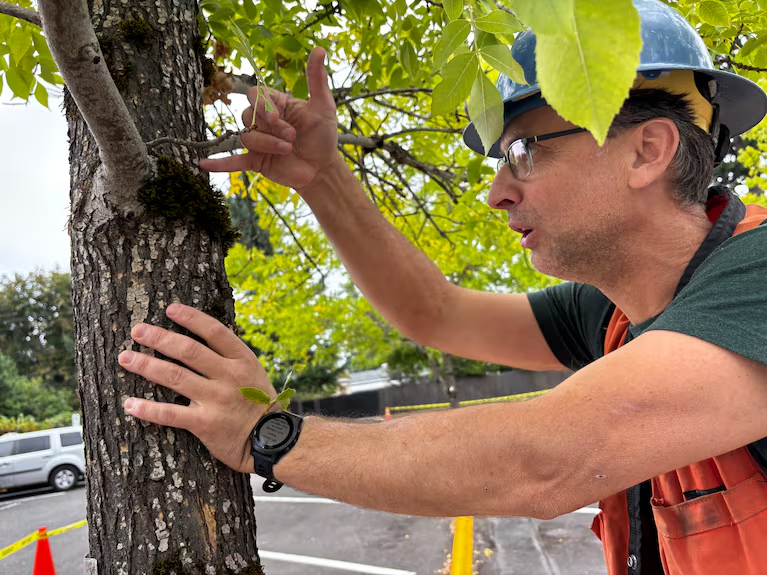PORTLAND, Ore. — Portland’s tree canopy is under threat as the emerald ash borer, a destructive invasive beetle, has been detected in the city. Forestry officials warn that the pest will spread quickly, leaving some neighborhoods with significant tree loss.
The emerald ash borer, a half-inch-long beetle with an iridescent green body, has already decimated ash tree populations across the Midwest. Now that it has reached Portland, experts say the city could lose most of its 95,000 ash trees within the next decade.
A Threat to Portland’s Streets
For many residents, the impact will be most visible along Portland’s tree-lined streets. According to the Portland Street Tree Inventory Project, there are more than 250,000 street trees citywide, with nearly 10,000 of them ash trees.
Also Read
The first confirmed infestation in Portland was detected in the Hazelwood neighborhood in Northeast Portland, where officials found infected trees near the David Douglas Aquatic Center. Those trees are slated for removal. Hazelwood has about 120 ash street trees, making up 1.9% of its total.
Neighborhoods at Highest Risk
While Hazelwood will feel the effects, other neighborhoods face a far greater threat due to higher concentrations of ash trees:
-
South Portland: Out of 4,285 street trees, 517 are ash trees (12.1%). Many line Macadam Avenue, making this area especially vulnerable.
-
Portland International Airport (PDX) area: With 770 inventoried street trees, 206 are ash (26.8%) — the highest concentration citywide. Dozens of these trees run along Northwest Alderwood Road near I-205.
-
Southwest Portland neighborhoods:
-
Collins View (along the Willamette River south of the Sellwood Bridge)
-
Bridlemile (west of Hillsdale)
-
Maplewood (west of Multnomah Village)
-
-
Other impacted areas: Richmond and Sellwood-Moreland in Southeast Portland, St. Johns and Portsmouth in North Portland, and Buckman in the city’s east side.
Experts say these areas could experience dramatic canopy loss if infestations spread unchecked.
Spread and Detection
The beetle was first identified in Forest Grove in 2022 and has since been detected in multiple Willamette Valley locations. The Portland find signals that infestations are accelerating.
“The pattern of spread in the eastern U.S. has been that populations at first increase slowly. But within a few years there is a rapid build-up, and it spreads in all directions at a faster pace,” said Cody Holthouse, manager of the Oregon Department of Agriculture’s Insect Pest Prevention and Management Program. “That’s exactly what we’re starting to see.”
Officials acknowledge that spotting the beetle is difficult, despite its bright coloring. “Finding one in a trap usually means there are quite a few already in that area,” Holthouse added.
Beyond Street Trees
Street trees make up only a fraction of Portland’s ash population. Officials estimate the city has about 68,000 ash trees in natural areas and 16,000 on private property. The widespread infestation will likely reshape Portland’s overall canopy in the coming years, with consequences for shade, habitat, and neighborhood character.
What Residents Can Do
The Oregon Department of Forestry is asking residents to help with early detection:
-
Report sightings by calling 1-866-INVADER or filing a report online.
-
Capture the beetle in a container if possible, or at least take a clear, close-up photo.
-
Check the state’s interactive detection map to see if you live in a quarantined area.
Quarantine rules prohibit cutting and transporting firewood out of infested zones to prevent further spread.
Infected trees can sometimes be treated with insecticides, though removal may be necessary in severe cases.
Kat Bethea, an emerald ash borer specialist for the Oregon Department of Forestry, urged residents to remain vigilant. “This helps us identify the insect much more easily, and it’s critical for slowing the spread.”
A Changing Canopy
For decades, Portland has invested in planting street trees to enhance livability. The arrival of the emerald ash borer threatens to undo years of progress, leaving neighborhoods unevenly impacted depending on how many ash trees they contain.
While forestry officials and residents work to slow the pest’s advance, one thing is certain: Portland’s streets — long shaded by ash-lined boulevards — will look very different in the years ahead.












